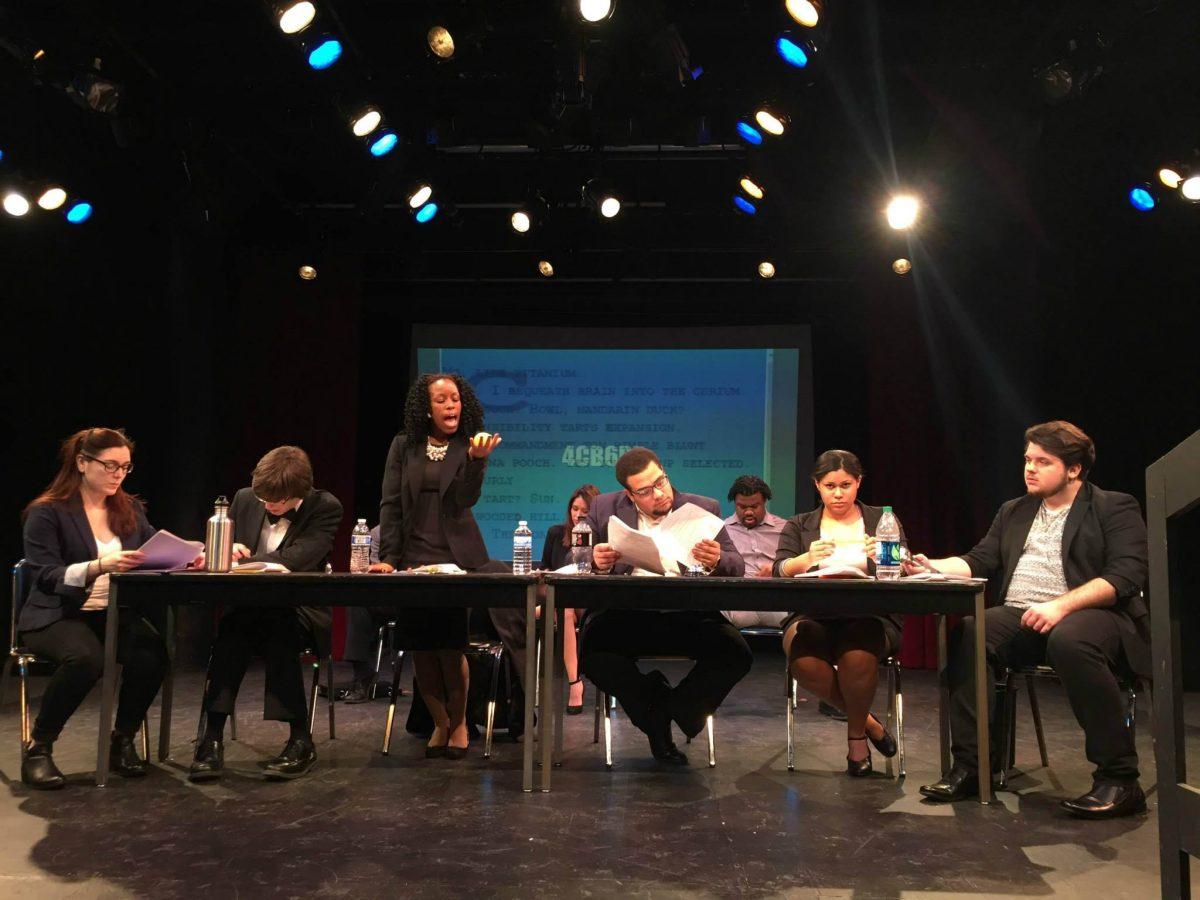Art is a tricky word.
Despite many efforts to pin down its exact meaning, the essence of art remains indefinable. Personally, I tend to define art as “anything that evokes an emotion.” I’m sure that many people would insist on clarification; art must be original and organic in its nature, and it must come from within a human mind.
That is a reasonable assumption to make – after all, a computer is not capable of producing any original work. It is programmed, given parameters. It cannot be creative, and therefore cannot produce art.
That statement was challenged last Thursday night by the Rutgers-NJIT Theatre Program’s one-off performance of Shy Nag: A Code Generated Opera, by Sonny Rae Tempest and NJIT’s Christopher Funkhouser.
The premise of the performance was deceptively simple– a computer was given an image, and somehow that image was converted into a readable script. Bradley Hall Theater scarcely fit all the students in attendance, some intrigued by that premise of a play written by a computer, others just seeking Honors colloquia credit.
Before the performance began, the co-writers and director took to the stage, introduced themselves, and informed the audience that they would have to “broaden their definitions of what theater is” for this particular libretto. Then, as the stage lights faded away, a repetitive plucking of a stringed instrument began, reminiscent of 8-bit tones from computers of another decade. This plucking gave way to the ear-piercing static of poor radio reception as strings of hexadecimal code flashed across a screen. When the static finally ceased, eight actors took the stage, to a sparsely populated set consisting of a few chairs, a table, and a podium. I was surprised to see that all the actors were carrying scripts. I did not realize that Shy Nag was literally a stage reading, as the playbill indicated.
What followed, I can describe in a single word. Nonsense.
The “script” of this piece was just words, words without real grammatical structure, without any sense of order, without actual meaning. My best imitation of the script would sound something like, “Envy. Sitting left, potato famine. The function? Cesium? Dumpling, doppelganger, doldrums! Parchment horse.”
This mindless reading continued for one hour. Apart from a few repetitive tropes, including two quick raps of wooden blocks and something to do with a mandarin duck, no underlying meaning presented itself during the performance– it just dragged on, and on, and on– and then, abruptly, it ended (thankfully).
Honors Theater Nights traditionally end with a talkback session with the director and cast. It gives the cast a chance to interact with the audience and answer any questions or shed some light on their process. This evening was no different, and the writers of Shy Nag also took the stage.
One question yielded a particularly interesting response from the writers. When prompted with the statement that the same script could have been written by “cutting out all the words from a dictionary, and then just randomly pulling them out of a bag,” Tempest and Funkhouser spoke more about the creative process behind Shy Nag.
First, an image was presented to a computer. The computer parsed the image to hex code, which was then split into seemingly arbitrary lengths of alphanumeric characters. All numbers were replaced with letters. These short, alphabetic strings were then run through a word processing program, which gave five or six suggestions for what words these meaningless strings could be corrected to. The writers chose which of the words to use.
Here, an argument reared its ugly head– Funkhouser and Tempest began to disagree about how the punctuation was placed in the script. One seemed to recall placing the punctuation manually, while the other insisted that the computer took care of that work. After a mildly heated exchange of words between the two men, the talkback session moved on.
I suppose a more apt description of Shy Nag, then, would be picking five or six words out of a bag containing a cut up dictionary, choosing one of them, and returning the rest. However, the important thing is this– Shy Nag is not a code-generated opera. It is a human-generated opera.
If a computer produced the libretto, then the computer could theoretically “undo” its work, and turn the script back into the same image. Shy Nag required far too much human interaction to become even remotely understandable English, and is not “undoable.” If the one underlying idea of the play was that a computer wrote it, yes, it probably still wouldn’t have been the most comprehendible work ever, but at least it would have had an excuse.
There was no excuse for this.
With human interaction at nearly every step of scripting Shy Nag, I would have hoped that at some point in time, one of the writers would have taken a step back, and realized that he was producing page after page of gibberish. Clearly, that did not happen.
If art is, by my definition, anything that produces emotion, then Shy Nag was, in fact, art. It made me angry. I was angry that my time was wasted. If, by another definition, art must come from the human mind, then yes, Shy Nag was still art, because Funkhouser and Tempest chose every single word of the script.
Thursday night, I learned an important lesson. Shy Nag is art. Shy Nag is intensely political, it is environmentally aware, it is a love triangle, it is all the things that the writers believed they put in the script. Art, however, like beauty, is in the eye of the beholder. I beheld Shy Nag. Shy Nag is art. Shy Nag is nonsense.


























